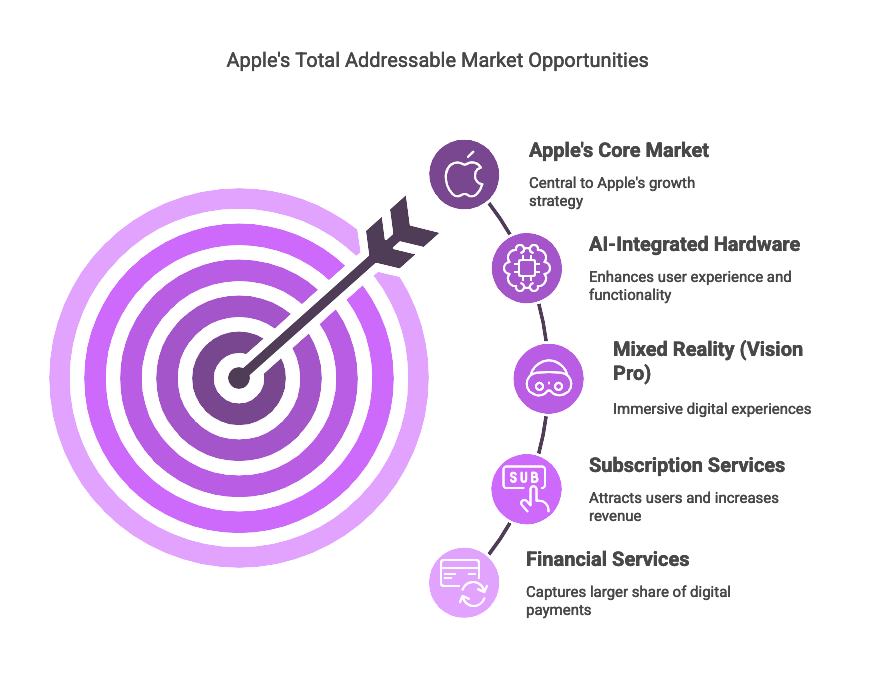What started as a garage project to make personal computing more human has become the most valuable—and quietly unstoppable—company on the planet. Apple Inc. (NASDAQ: AAPL), once known for its colorful Mac computers, is now a $3T+ titan that has reshaped how we communicate, create, and consume. Its ambition? To make tech so seamless, so intuitive, so embedded in your life—you barely notice it’s there.
Apple isn’t just building devices. It’s orchestrating a closed-loop, ultra-premium ecosystem with few exits and infinite upsell paths. It’s not a phone company anymore—it’s the operating system for your life.
How Does Apple Make Money?
Hardware + Services = Experience Flywheel
Apple runs the most elegant and addictive consumer ecosystem in tech:
iPhone: The flagship product that’s more cultural artifact than phone.
Mac, iPad, Wearables: Expanding screen sizes and use cases.
App Store + Subscriptions: 2B+ active devices = recurring revenue goldmine.
iCloud, Apple Music, TV+, Fitness+: Growing digital services footprint.
Apple Silicon + AI: Vertical integration with serious performance and privacy perks.
Source: wccftech.com - Omar Sohail
📊 Recurring Revenue Wins: In Q1 2025, Apple’s services hit $24B+ in quarterly revenue—nearly 20% of total sales—with margins approaching 70%.
Our Take: Apple’s services business is quietly becoming a software empire within a hardware shell. That’s the real magic trick.
Management, Culture and Skin in the Game
Founder DNA Still at the Core
Steve Jobs built Apple with an obsession for simplicity and soul. Today, Tim Cook runs it with precision and scale—and the vision still resonates.
Cook’s Apple: More operationally efficient, more globally expansive, more shareholder-focused.
Skin in the Game: Cook holds >3 million shares, and Apple insiders own billions in equity.
Our Take: You can feel Jobs’ ethos in the product design—and Cook’s discipline in the numbers. It’s a rare blend of art and execution.
Capital Allocation & Efficiency
Apple returned $110B to shareholders in 2024—while still investing in chips, AI, and health tech.
ROE: 147%
ROIC: 60%
CapEx to Op Cash Flow: Under 7%
Our Take: Apple prints cash and spends it like a long-term compounder. It’s not just buying back stock—it’s buying back future dilution while growing.
Competitive Advantage
✅ What’s working:
Vertical integration (hardware, software, services)
Customer lock-in and brand loyalty
Recurring, high-margin Services engine
$100B+ in free cash flow to reinvest annually
❌ What’s missing:
Heavy reliance on iPhone (~50% of revenue)
Slowing upgrade cycles in mature markets
Potential regulatory headwinds (App Store, antitrust scrutiny)
Moat Score: Wide. Durable. Still expanding.
Valuation & Margin of Safety
Not Cheap, But Never Was
P/E: 30.9x
P/FCF: 30.1x
Apple trades at a premium—but not for hype. Investors are buying consistency, durability, and innovation. However, at this size, every new vertical must meaningfully move the needle.
At ~30x earnings, Apple isn’t in value territory. But it hasn’t been since the iPhone 4.
DCF suggests modest upside—but the optionality in AI, health, and wearables is hard to model.
At 8–9% FCF growth, Apple’s valuation closely matches its current market cap (~$2.8T).
To justify a significant upside, Apple would need to sustain 12–15% growth in free cash flow—challenging at its scale.
At 5–7% growth, Apple appears slightly overvalued based on traditional DCF analysis.
Our Take: You’re not buying low. You’re buying dominant. And dominant has staying power.
The Balance Sheet: War Chest Mode
Free Cash Flow to Total Debt: 1.26x
Operating Cash Flow to Debt: 1.37x
Goodwill to Assets: 0% (minimal M&A bloat)
Cash & Equivalents: $60B+
Apple has fortress-level liquidity, minimal debt reliance, and the flexibility to innovate, repurchase, and defend its moat—even in turbulent markets.
Our Take: Apple could buy most Fortune 500s in cash. But it’s disciplined, efficient, and quietly spending on the future—on its own terms.
Market Potential
The Next $1T of Growth
AR/VR (Vision Pro)
Health + Wearables
Fintech (Apple Pay, Savings, BNPL)
Generative AI + On-Device Intelligence
Emerging Markets: India, LATAM
Our Take: Apple has earned the right to create new categories—and monetize them. It’s not just scaling—it’s spawning.
Performance Comparison
Apple: +192.78% over 5 years
S&P 500 (VOO): Trailing significantly
Apple is one of the most consistent and reliable performers in the market. It's not just a tech titan—it’s a cornerstone of long-term portfolios, including Warren Buffett’s Berkshire Hathaway, which has held Apple as its largest position (over 28% of the portfolio) for more than a decade.
Crushing FAANG & Device Peers
2024: +40% stock return
Services growing faster than Google Cloud
Vision Pro launched a new category
Our Take: Microsoft might own productivity, but Apple owns the consumer. And everyone else is reacting to their roadmap.
Risks & Hurdles
✅ Apple’s Playbook
Diversification Strategy:Apple continues to reduce iPhone dependency by growing Services, Wearables, and new platforms like Vision Pro and Apple Health.
First-Mover Advantage & Brand Trust:Apple’s legacy of innovation and customer trust gives it an edge—especially when launching into new verticals like spatial computing and AI.
Closed Ecosystem:Apple’s tight integration of hardware, software, and services makes it hard for users to switch—boosting retention, margins, and lifetime value.
Operational Excellence:Tim Cook’s background in operations ensures that Apple can execute at global scale, even in times of volatility.
Our Take: Apple’s biggest risk is its size—and its success. But its integration, privacy moat, and customer loyalty are decades deep.
Final Word: The Quiet King of Consumer Tech
Apple isn’t the loudest innovator—but it’s the most disciplined. Its ecosystem is closed, but its upside is wide open. It’s not chasing trends—it’s shaping them.
With recurring revenues, vertical integration, and AI-ready hardware in place, Apple has more optionality than any tech company on Earth. This isn’t about buying the next hot thing—it’s about owning the best version of everything.











